Self-propelled artillery installation "Object 120"
By the mid-fifties, Soviet scientists and engineers had worked out the issue of equipment tanks and other combat vehicles with missile weapons. Missile systems had a very high potential, and therefore from a certain time they were considered as a means of completely replacing existing artillery anti-tank systems. Nevertheless, such projects were highly complex, which is why their development could be delayed. In this regard, as an aid to missile tanks, it was decided to create a new artillery self-propelled gun with a high-powered gun.
In May 1957, the USSR Council of Ministers issued two decrees, according to which the defense industry was to create several new types of equipment. It is curious that the decision to develop an armored vehicle with artillery armament came out a few weeks earlier than a similar document requiring the creation of a rocket tank. New research work in the field of self-propelled artillery received the code "Taran".
The head developer of the promising ACS was assigned to the OKB-3 of the Sverdlovsk Uralmashzavod. GS was to supervise the work. Yefimov. The creation of the artillery unit was commissioned by the Perm plant No.172. These enterprises already had a lot of experience in creating self-propelled artillery and various weapons, which made it possible to successfully solve all the tasks.
The project of perspective self-propelled guns received the working designation “Object 120”, which was used in parallel with the name of the topic. In addition, in some sources the car is designated as SU-152, but this name can lead to confusion, since during the years of the Great Patriotic War, the model of the same name was already produced and was in service.
Until the end of 1957, the necessary studies were carried out, the purpose of which was to select the optimal caliber of the gun for the Taran. Taking into account the current progress in the field of tank armor and armaments, it was decided that the systems 130 and 152 mm have the greatest prospects. Two M-68 (130 mm) and M-69 (152 mm) guns projects were developed. In the near future it was supposed to produce prototypes of such systems and determine their real capabilities in the conditions of the landfill.
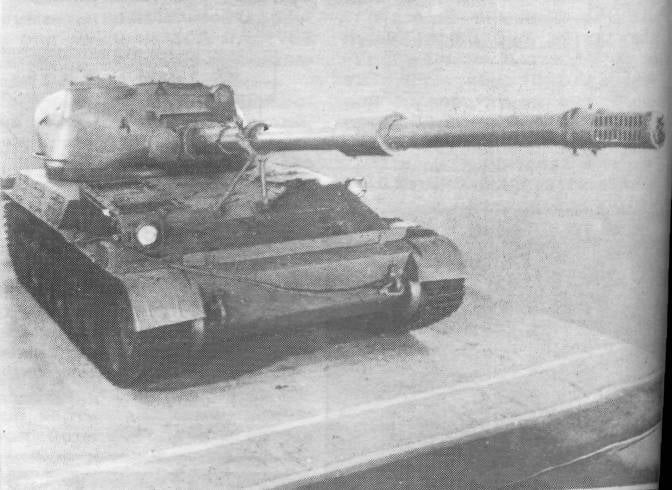
Layout SAU. Photo Russianarms.ru
In 1958, Plant No. 172 manufactured experimental trunks, with the help of which it was planned to conduct a new stage of testing. Comparative tests have shown that, despite the significant difference in calibers, guns are superior to one another in some indicators and lose in others. So, 152-mm gun used a heavier armor-piercing projectile, but it accelerates to lower speeds. M-68, in turn, was ahead of the heavier armor penetration system at zero meeting angles, whereas with increasing angle it showed less high performance. In general, from the point of view of technical characteristics, the two guns were equivalent.
The most important advantage of the X-NUMX-mm M-152 cannon has become the proposed range of ammunition. Unlike a smaller system, it could use cumulative projectiles. The high power, the gain in some characteristics and the presence of a cumulative shot resulted in the fact that M-69 was recommended for use on the “69 Object”. Thus, the caliber 120 mm was finally chosen.
In parallel with the choice of weapons was the issue of the chassis. Since the end of the forties, Uralmashzavod has been working on three promising self-propelled guns, built on the basis of a unified chassis. The latter was based on a number of original ideas and used some new solutions for domestic technology. Nevertheless, the novelty had a negative impact on the course of the project, because of which, even after several years of refining, the chassis retained a number of serious flaws. By the time Nira Taran was launched, two projects out of three were closed, and the development of the SU-100P self-propelled gun was still ongoing, but in order to create a new chassis. It was a modified version of an existing armored vehicle that was proposed to be used in a new project.
The proposed 152-mm cannon was large and made appropriate demands on the fighting compartment. In this regard, it was decided not to use the SU-100P chassis, but its modified version, based on the basic ideas of the closed SU-152П project. In this case, the problem of dimensions was solved by lengthening the body and adding a pair of road wheels. Thus, the new “120 Object” was supposed to be based on a refined and improved 7k chassis.
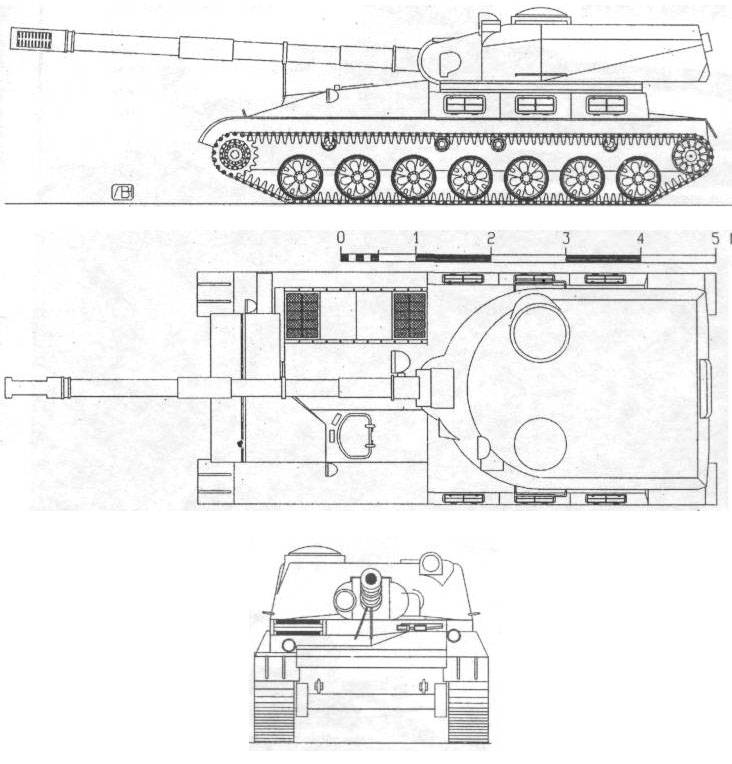
Projections of "Taran". Figure Russianarms.ru
The corps retained the overall architecture and layout, but now some reinforcement of armor protection and a certain change in the shape of the aggregates were proposed. To increase the level of protection, the thickness of the front sheets was increased to 30 mm. Other hull elements were 8 mm thick. Bronelists were connected by welding. Riveted connections in the new project were not used. In the frontal part of the hull, transmission units were still located, behind which were the control compartment (left) and the engine compartment. The aft part of the hull stood out under the fighting compartment with a full-fledged swivel tower.
Despite some design changes, the body of the 120 Object externally looked like an existing design. The frontal projection was protected by several inclined sheets placed at different angles to the vertical. The front of the case had a sloping roof, equipped with hatches for the driver and for access to the engine compartment. Behind the engine compartment was a horizontal roof with a shoulder strap for installing the tower. The hull retained vertical sides, on which, however, boxes for property appeared. An interesting feature of the updated hull was the ledge at the top of the stern.
The armament of the self-propelled gun was to be placed in a full-turn turret, providing protection for the crew and ammunition from all threats. The use of a cast tower of a relatively complex shape was suggested. The frontal and central part of the tower had a shape that was close to hemispherical. Behind on the main unit was mounted a large feed niche, necessary for placing piles. On the roof of the tower, at its left side, there was a commander's turret. There were also hatches and openings for viewing devices or sighting devices.
Self-propelled gun "Taran" retained the power plant and transmission, developed in the framework of the project SU-100П. In the engine compartment fit diesel engine B-105 400 horsepower. The engine mated with a mechanical transmission. It consisted of a main friction clutch for dry friction, a two-stream gear and turning mechanism, as well as two single-stage side-mounted gearboxes. Due to the small size of all the transmission units were placed in the engine compartment and the front of the case.
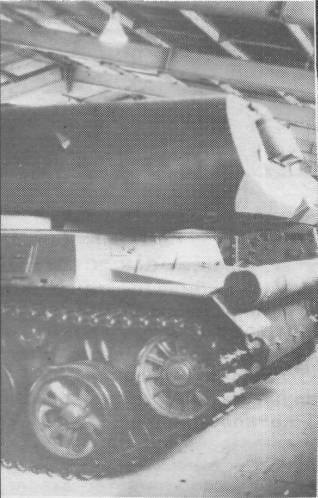
Self-propelled feed: you can consider improvements to the base chassis. Photo Russianarms.ru
The undercarriage was based on the developments of the SU-152P project, but it was refined based on the experience of the further development of the unified chassis. On each side, with the help of an individual torsion suspension, seven double rubberized road wheels were placed. The front and rear pairs of rollers were amplified by hydraulic shock absorbers. In front of the hull were driving wheels, in the stern - guides. Support rollers were installed above the support rollers: four such parts were placed at unequal intervals between them. A characteristic feature of the “120 Object”, as well as its predecessors, was the use of a caterpillar with a rubber-metal hinge. However, by the end of the fifties, this was no longer an innovation, since the industry had managed to master the production of several samples of equipment with such tracks.
The main weapons The ram was supposed to be an X-NUMX-mm M-152 rifled gun. This gun had a barrel length 69 caliber with a muzzle-type muzzle brake and an ejector. Used semi-automatic wedge gate. The cannon assembly was completed with hydropneumatic recoil devices, which made it possible to obtain a rollback length of the entire 59,5 mm. Horizontal guidance was performed by turning the entire tower with the help of mechanical drives. Hydraulics was responsible for the vertical tip. There was the possibility of firing targets in any direction at the corners of the vertical pickup from -300 ° to + 5 °. The gunner’s workplace had a TS-15 day sight and a night periscope system that needed to be illuminated. The spotlight was placed next to the gun mask.
The gun M-69 used a separate-sleeve loading and could use several types of ammunition. For the destruction of manpower and fortifications, high-explosive fragmentation shells with a mass of 43,5 kg, used with missile charges with a weight of 10,7 and 3,5 kg, were intended. It was proposed to fight with armored vehicles with the help of cumulative and sabot projectiles. The latter had a mass of 11,5 kg and shot 9,8-kg propellant charge. Having an initial speed of 1720 m / s, such ammunition at a distance of 3500 m could penetrate up to 295 mm of armor. With 1000 m at an angle of encounter 60 ° 179 mm were penetrated. Self-propelled gun "Object 120" took on board only 22 shot separate loading. Ammunition was transported in aft laying tower. In order to simplify the work of the crew, a mechanical rammer was used, and after the shot, the gun automatically returned to the loading angle.
An additional weapon of the new self-propelled gun could be a heavy machine gun KPV. This weapon could be placed on the turret of one of the hatches in the roof of the tower. In addition, for self-defense crew could use personal small arms and hand grenades.

Renovation of the 120 Object. Figure Dogswar.ru
The crew was to consist of four people. In front of the hull, in the management department, there was a driver. His workplace kept all the funds foreseen by previous projects. Get into the control compartment followed through the hatch in the roof. For driving in a combat situation, the driver had a couple of periscope instruments. The commander, gunner and loader were placed in the tower. The place of the commander was to the right of the gun, the gunner - to the left. The charger was behind them. Access to the fighting compartment was provided by a pair of roof hatches. The crew had an intercom and a radio station P-113.
Self-propelled artillery installation of a new type has turned out quite large. The hull length reached 6,9 m, the length with the cannon was about 10 m. The width was 3,1 m, the height was slightly more than 2,8 m. The combat weight was determined in 27 t. With these parameters, the Taran armored car could reach speeds of more than 60 km / h and overcome at one refueling 280 km. Ensured a fairly high cross on rough terrain. Water barriers should be overcome by fords.
The development of the project “Object 120” / “Taran” was completed in 1959, after which Uralmashzavod began assembling a prototype. At the very beginning of next year, the Perm gunsmiths manufactured two M-69 experimental guns and sent them to Sverdlovsk. After mounting the guns, the built prototype was ready for testing. In the near future it was planned to test the armored vehicles at the factory site, which was necessary for the subsequent refinement and improvement of the equipment.
It is known that the experienced "Ram" repeatedly went to the track of the landfill and walked a considerable distance along it. In addition, as part of the factory tests, several shots were fired at targets. Such checks allowed us to determine the scope of further work and begin to improve the existing design.
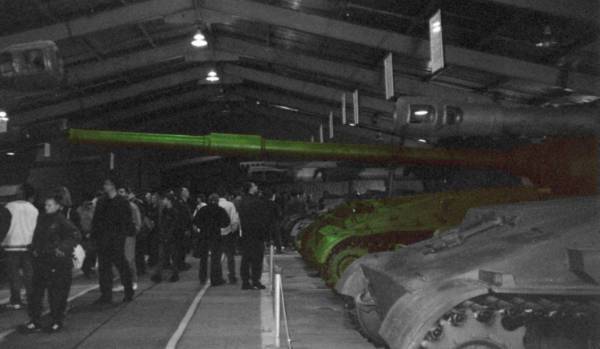
Self-propelled gun (highlighted in green) in the museum hall. You can estimate the proportions of the gun without the muzzle brake. Photo Strangernn.livejournal.com
However, the refinement of the experimental technology did not last too long. Already 30 May 1960, the USSR Council of Ministers decided to stop the research work "Taran". This decision was justified by the progress in the artillery and missile areas. By the early sixties, more sophisticated anti-tank missile systems were created, and in addition, ideas and solutions emerged that made it possible to create smooth-bore guns with high characteristics. For example, based on new technologies, the 125-mm tank gun 2А26 was soon created, which had certain advantages over the existing M-69. Further development of the 2А26 product led to the emergence of the 2А46 family systems, which are still in service. There is also a version according to which the abandonment of the “Taran” project was associated with pressure from supporters of rocket weapons. Previously, they managed to get rid of three projects of ACS, and the new project could also become their “victim”.
Anyway, at the very end of spring 1960, the work on the topic “Ram” was stopped. New prototypes were not built and tested. The unique and interesting machine remained in a single copy. The no longer needed prototype of the ACS “Object 120” was later transferred to the Kubinka Armored Museum, where it remains to this day. The use of long-barreled tools led to interesting consequences. Even after dismantling the large muzzle brake, the self-propelled gun does not fit into the existing exhibition hall very well: the barrel of the “shortened” barrel reaches the opposite equipment.
In 1957, two projects of promising anti-tank equipment were launched, one of which involved the construction of an artillery self-propelled gun, and the second a rocket tank. As a result, the “120 Object” was constantly compared to the “150 Object” / IT-1 machine. Each of the two samples exceeded its competitor in some characteristics, while in the others it was inferior to it. Nevertheless, in the end, the missile tank was considered more perfect and successful, as a result of which it entered service and was produced in a small series. The project "Ram", in turn, was closed.
However, the developments on the "120 Object" did not disappear. A few years after the closure of this project, work began on new self-propelled artillery installations for various purposes. When creating them, already known and proven solutions borrowed from closed projects were used in the most active way. Thus, the "Object 120" / "Taran" ACS and previous designs, which were abandoned at the time, were still able to help further the development of Russian self-propelled artillery.
On the materials of the sites:
http://dogswar.ru/
http://russianarms.ru/
http://bastion-karpenko.narod.ru/
http://shushpanzer-ru.livejournal.com/
http://strangernn.livejournal.com/
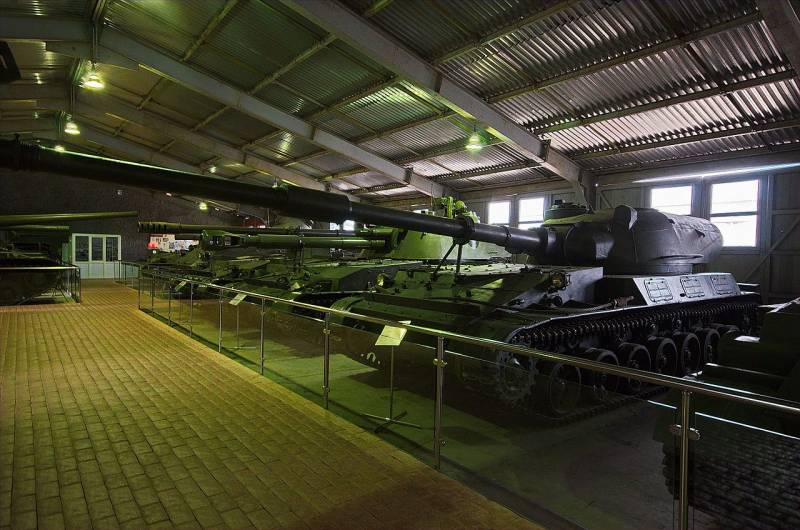
Information